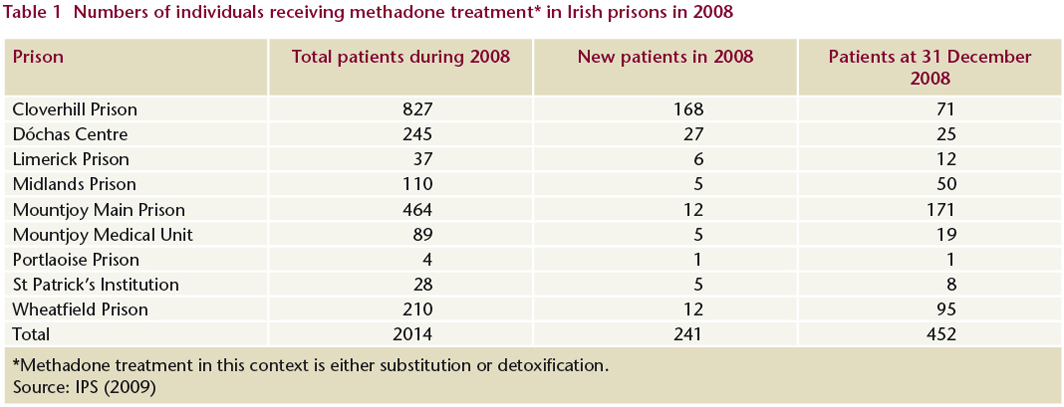Lyons, Suzi and Moore, Joan
(2010)
Irish Prison Service annual report 2008.
Drugnet Ireland,
Issue 33, Spring 2010,
pp. 24-25.
The Irish Prison Service (IPS) annual report for 20081 notes a number of developments in relation to healthcare and drug treatment and reintegration services, as well as presenting data on drug offenders in custody and outlining the enhanced security measures in place to prevent access to contraband. These sections of the report are summarised in this article.
Healthcare services
The aim of the prison healthcare service is to provide prisoners with access to the same quality and range of health services as that available to those entitled to general medical services in the community, and which are appropriate to the prison setting.
Nursing
Nurse managers were in post in all closed prisons and in the three main prison complexes: Mountjoy, Cloverhill and Wheatfield, and Midlands and Portlaoise. The report states that this has significantly impacted on the co-ordination, organisation and quality of healthcare services in the IPS. Specific addiction nursing posts were also created, mainly in Mountjoy prison.
Pharmacy services
Professional pharmacy services were available in all except one prison (they were to be introduced in Cork prison in 2009). In addition, prisoners in Mountjoy/Dóchas complex had access to a drug treatment pharmacy service. This service dispensed methadone to approximately 200 patients every day.
Mental health
The report notes the high prevalence of mental health problems in the prison population and the importance of providing care in the most appropriate facility. In the latter part of 2008 some 15 prisoners a week were waiting for admission to the Central Mental Hospital (CMH). In November 2008 the HSE agreed to provide 10 extra beds in the CMH, and although these beds were not solely for the use by the prisons, they have gone some way to reducing the waiting list for this service.
In-reach services
In-reach medical services are available in a number of the prison sites:
- Dental services from the Dublin Dental Hospital – in seven Dublin prisons
- Consultant-led psychiatric services from the CMH – in all Dublin prisons and in Portlaoise/Midlands
- Consultant-led addiction services – in Cloverhill/Wheatfield and in the Mountjoy complex.
Deaths in custody
In 2008 there were 11 deaths in custody, an increase of five on the 2007 figure. The inquests were not closed in any of these cases so exact cause of death was not known. Every death in custody is examined by a multi-disciplinary group, and significant findings are shared with other sites. The report states that there are strategies in place to help prevent self-harm and suicide.
Drug treatment services
Merchants Quay Ireland completed the implementation of its national prison-based addiction counselling service in 2008. This service is available to all prisoners who require it, and provided in excess of 1,000 counselling hours per month to a total of 440 prisoners in 13 prisons in 2008.
Methadone maintenance treatment was available in eight of the 14 prisons (covering 80% of the prison population). The report notes that in 2008 the IPS was the largest single provider of methadone maintenance treatment, treating an average of 650 patients per month, and a total of 2,014 in the year (Table 1). This represents a 28% increase on 2007 figures. Of these, 241 had never been in treatment before (Table 1).
The IPS published a Drug treatment clinical policy in January 2008 to provide guidance to health professionals when treating addiction in prison.2

Reintegration – homelessness
The report refers to homelessness among ex-prisoners as an ongoing problem; 894 prisoners accessed the in-reach community welfare service provided by the Homeless Persons Unit of the HSE in 2008, an increase of 304 on the 2007 figure. A pilot service run by Focus Ireland in Cloverhill prison has provided a case management and pre-settlement service for 68 homeless remand prisoners since it started in September 2007.
Drug offenders in custody
On 5 December 2008 there were 567 people (550 males and 17 females) serving sentences for drug offences – 15% of the total number (3,695) in custody on that date, and 20% more than the comparable figure of 472 in 2007.
During 2008, 637 people (595 males and 42 females) were committed under sentence for drug offences, representing 8% of total committals under sentence in the year, compared to 8.2% in 2007. Thirty-six drug offenders were committed under sentence of more than 10 years, an increase on the 2007 figure of 22. Table 2 shows the numbers in custody on 5 December 2008 and the numbers committed during 2008, by sentence length.

Security measures
The roll-out of a package of enhanced security measures in closed prisons to prevent access to contraband items, primarily mobile phones, drugs and weapons, began in May 2008. The new measures include operational support (dedicated search teams), security screening (airport-style detectors and scanners) and drug-detection dog teams (16 teams came into operation in 2008). Some 2,047 mobile phones were seized by prison authorities in 2008. The first module of a pilot project to install technology to prevent the use of mobile phones was completed in the Midlands prison in November 2008, and a second module was started in Portlaoise prison.
There were 759 incidents of violence among prisoners, some of them very minor. According to the report, 'Attacks by prisoners on prisoners are often related to matters on the outside – such as drug debts or gang rivalry, or perceived co-operation with gardaí.'
1. Irish Prison Service (2009) Irish Prison Service annual report 2008. Longford: Irish Prison Service.
2. This document can be found at
www.irishprisons.ie/Healthcarepolicies060209.doc

